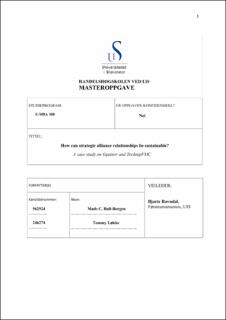| dc.contributor.advisor | Ravndal, Bjarte | |
| dc.contributor.author | Bull-Borgen, Mads Christian | |
| dc.contributor.author | Løkke, Tommy | |
| dc.date.accessioned | 2020-08-06T12:31:47Z | |
| dc.date.available | 2020-08-06T12:31:47Z | |
| dc.date.issued | 2020-05-26 | |
| dc.identifier.uri | https://hdl.handle.net/11250/2671105 | |
| dc.description | Executive Master’s thesis in Business Administration | en_US |
| dc.description.abstract | This paper will take you through how client-supplier relationships will be sustainable in the oil and gas market. As seen in the past years, suppliers and oil and gas operators are shifting their strategies to work closer together. In our case study, we have looked at how Equinor and TechnipFMC as an example of how they both can enforce the vision of a sustainable alliance relationship. The client is taking on the recent market trend of increasing more scope to their trusted partners, known as Integrated supply. The supplier is empowered to provide a wider scope to their clients, and often done so in alliance relationships. The question of sustainability between such companies has yet been tested, and has raised the following thesis question, “How can Alliance Relationships be sustainable?”. This paper discusses how the selected participants of our case study would enforce the vision set for sustainable alliance relationships.
The idea and purpose of this paper has been to explore what choices Equinor and TechnipFMC would make in order to create a sustainable alliance. We have conducted interviews to address how they would enforce their visions set for such partnerships. As we discuss our thesis question against the chosen model The Alliance Pillars (Figure 6)5
the envisioned Pillars by Equinor to engage in alliance relationships. Those pillars are discussed through selected theories; Trust, Governance, Transaction cost, Innovation, Capabilities and Change management.
The paper has identified the importance of sustainability in strategic alliance relationships. However, a few weaknesses have been identified as we have progressed. We both work for these large companies with only one case study to test these theories. We expected to discover that the integrated supply would hold key significance in entering an alliance. Our discovery was entirely different, where the contracting theories have shown through the alliance pillars that were introduced by Equinor, that strategic alliance relationships could be sustainable by applying the Equinor alliance pillar model (Figure 6). Some recommendations were provided showing the importance of change management, trust, sustainable partnerships and, the importance of foreseeability in relation to both innovation and sustainability. | en_US |
| dc.language.iso | eng | en_US |
| dc.publisher | University of Stavanger, Norway | en_US |
| dc.relation.ispartofseries | Masteroppgave/UIS-HH/2020; | |
| dc.subject | økonomi | en_US |
| dc.subject | administrasjon | en_US |
| dc.subject | ledelse | en_US |
| dc.subject | strategisk allianse | en_US |
| dc.subject | kontrakt | en_US |
| dc.title | How can strategic alliance relationships be sustainable? | en_US |
| dc.type | Master thesis | en_US |
| dc.subject.nsi | VDP::Social science: 200::Economics: 210::Business: 213 | en_US |
